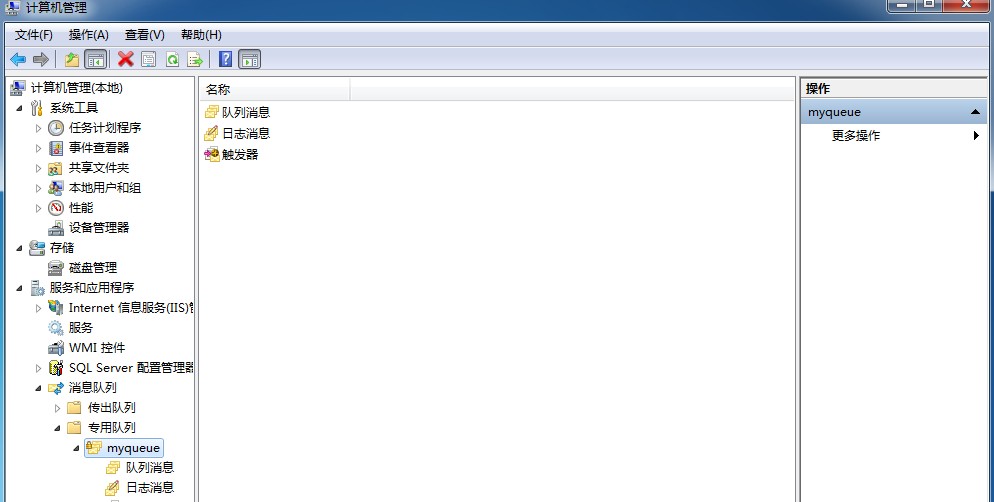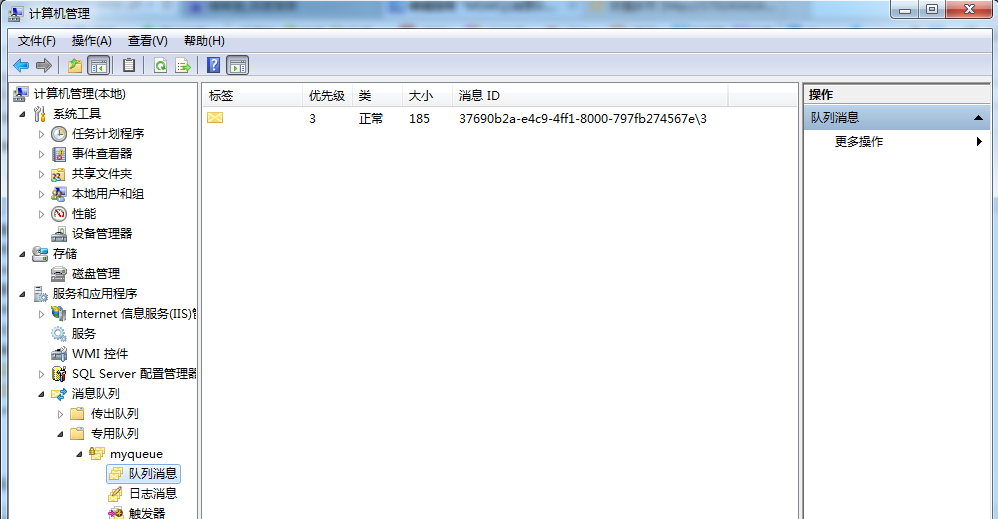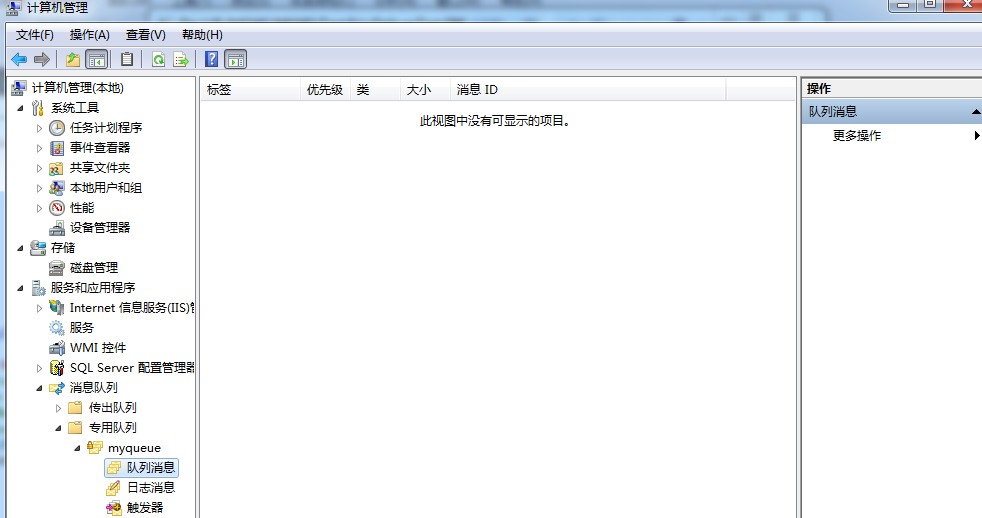Message
Message是MSMQ的数据存储单元,我们的用户数据一般也被填充在Message的body当中,因此很重要,让我们来看一看其在.net中的体现,如图:

在图上我们可以看见,Message提供了三个构造函数,参数body表示我们的用户数据,当我们在构造函数中传入,数据最终会被赋值给其同名属性body,参数formatter对应同名属性Formatter,它是一个序列化器,当我们的用户数据是一个复杂类型,比如类的时候Message会自动采用该序列化器将我们的复杂类型序列化。message支持3种序列化对象:
-- XMLMessageFormatter对象----MessageQueue组件的默认格式化程序设置。
-- BinaryMessageFormatter对象;
-- ActiveXMessageFormatter对象;
由于后两者格式化后的消息通常不能为人阅读,所以我们经常用到的是XMLMessageFormatter对象。该对象构造方法有三种重载:
public XmlMessageFormatter(); public XmlMessageFormatter(string[] targetTypeNames); public XmlMessageFormatter(Type[] targetTypes);
MSMQ队列
消息(Message)需要保存在msmq队列中,.net中采用System.Messaging.MessageQueue来管理MSMQ队列,它提供能操作MSMQ的绝大多数API,比如
1.判断指定路径的队列是否存在。其中path代表队列的路径,表示形式为"主机名队列名称",例如:".private$myQueue",其中"."代表本地主机,"private$myQueue"则代表队列的名称,"private$"表示我们创建的是专用队列,在网络上我们可以通过路径来唯一确定一个队列。
public static bool Exists(string path);
2.创建队列。path代表队列的路径,transactional表示是否创建事务队列,默认为fasle。关于事务队列我在上一篇做了详细的论述,这里不在重复。
public static MessageQueue Create(string path); public static MessageQueue Create(string path, bool transactional);
3.删除队列
public static void Delete(string path);
4.发送消息到MSMQ。obj代表我们的用户数据,transation表示将我们的发送操作纳入事务当中。在前面我们说过MSMQ接收的是Message,但是在这里我们看到Send操作并未强制要求我们采用Message类型参数。这是因为当我传入一个Object参数数据时,在Send操作的内部自动的给我们创建了一个Message消息对象,并且将我们的传入的Object参数采用默认的序列化器序列化,然后装入Message的body属性当中,如果我们在Send方法中指定label属性,它将被赋值给Message的同名Label属性。当然我们完全可以自定义一个message对象传入Send方法中
public void Send(object obj); public void Send(object obj, MessageQueueTransaction transaction); public void Send(object obj, string label);
5.接收消息。同理接收消息也可以被纳入事务当中,采用Receive方法在取MSMQ的消息时,如果成功,会把MSMQ的对应消息给删除掉,并且只能取到消息队里中的排队头的消息。
public Message Receive(); public Message Receive(MessageQueueTransaction transaction); public Message Receive(TimeSpan timeout);
如果我们想取指定标识的消息,就的采用如下的方法了,id代表消息的唯一标示。
public Message ReceiveById(string id); public Message ReceiveById(string id, MessageQueueTransaction transaction);
如果我们在接收消息的后,不想把MSMQ队列中的消息删除怎么办呢?那么采用下面的方法吧,因为这两个方法接收MSMQ的消息,不会删除MSMQ中对应的消息,所以他们不支持事务,即没有提供事务的参数。
public Message Peek(); public Message PeekById(string id);
我们也可以一次性吧队列里面的所有消息取出来
public Message[] GetAllMessages();
实例
说了这么多,下面让我们来代码实战一下,我们采用控制台程序做测试,我把MSMQ队列做了简单的封装,如下
using System; using System.Collections.Generic; using System.Linq; using System.Messaging; using System.Text; using System.Threading.Tasks; namespace Test { public class QueueManger { /// <summary> /// 创建MSMQ队列 /// </summary> /// <param name="queuePath">队列路径</param> /// <param name="transactional">是否事务队列</param> public static void Createqueue(string queuePath, bool transactional = false) { try { //判断队列是否存在 if (!MessageQueue.Exists(queuePath)) { MessageQueue.Create(queuePath); Console.WriteLine(queuePath + "已成功创建!"); } else { Console.WriteLine(queuePath + "已经存在!"); } } catch (MessageQueueException e) { Console.WriteLine(e.Message); } } /// <summary> /// 删除队列 /// </summary> /// <param name="queuePath"></param> public static void Deletequeue(string queuePath) { try { //判断队列是否存在 if (MessageQueue.Exists(queuePath)) { MessageQueue.Delete(@".private$myQueue"); Console.WriteLine(queuePath + "已删除!"); } else { Console.WriteLine(queuePath + "不存在!"); } } catch (MessageQueueException e) { Console.WriteLine(e.Message); } } /// <summary> /// 发送消息 /// </summary> /// <typeparam name="T">用户数据类型</typeparam> /// <param name="target">用户数据</param> /// <param name="queuePath">队列名称</param> /// <param name="tran"></param> /// <returns></returns> public static bool SendMessage<T>(T target, string queuePath, MessageQueueTransaction tran = null) { try { //连接到本地的队列 MessageQueue myQueue = new MessageQueue(queuePath); System.Messaging.Message myMessage = new System.Messaging.Message(); myMessage.Body = target; myMessage.Formatter = new XmlMessageFormatter(new Type[] { typeof(T) }); //发送消息到队列中 if (tran == null) { myQueue.Send(myMessage); } else { myQueue.Send(myMessage, tran); } Console.WriteLine("消息已成功发送到"+queuePath + "队列!"); return true; } catch (ArgumentException e) { Console.WriteLine(e.Message); return false; } } /// <summary> /// 接收消息 /// </summary> /// <typeparam name="T">用户的数据类型</typeparam> /// <param name="queuePath">消息路径</param> /// <returns>用户填充在消息当中的数据</returns> public static T ReceiveMessage<T>(string queuePath,MessageQueueTransaction tran=null) { //连接到本地队列 MessageQueue myQueue = new MessageQueue(queuePath); myQueue.Formatter = new XmlMessageFormatter(new Type[] { typeof(T) }); try { //从队列中接收消息 System.Messaging.Message myMessage = tran == null ? myQueue.Receive() : myQueue.Receive(tran); return (T)myMessage.Body; //获取消息的内容 } catch (MessageQueueException e) { Console.WriteLine(e.Message); } catch (InvalidCastException e) { Console.WriteLine(e.Message); } return default(T); } /// <summary> /// 采用Peek方法接收消息 /// </summary> /// <typeparam name="T">用户数据类型</typeparam> /// <param name="queuePath">队列路径</param> /// <returns>用户数据</returns> public static T ReceiveMessageByPeek<T>(string queuePath) { //连接到本地队列 MessageQueue myQueue = new MessageQueue(queuePath); myQueue.Formatter = new XmlMessageFormatter(new Type[] { typeof(T) }); try { //从队列中接收消息 System.Messaging.Message myMessage = myQueue.Peek(); return (T)myMessage.Body; //获取消息的内容 } catch (MessageQueueException e) { Console.WriteLine(e.Message); } catch (InvalidCastException e) { Console.WriteLine(e.Message); } return default(T); } /// <summary> /// 获取队列中的所有消息 /// </summary> /// <typeparam name="T">用户数据类型</typeparam> /// <param name="queuePath">队列路径</param> /// <returns>用户数据集合</returns> public static List<T> GetAllMessage<T>(string queuePath) { MessageQueue myQueue = new MessageQueue(queuePath); myQueue.Formatter = new XmlMessageFormatter(new Type[] { typeof(T) }); try { Message[] msgArr= myQueue.GetAllMessages(); List<T> list=new List<T>(); msgArr.ToList().ForEach((o) => { list.Add((T)o.Body); }); return list; } catch(Exception e) { Console.WriteLine(e.Message); } return null; } } }
我们的用户实体也很简单,如下
using System; using System.Collections.Generic; using System.Linq; using System.Text; using System.Threading.Tasks; namespace Test { public class Student { /// <summary> /// 年龄 /// </summary> public int Age { get; set; } /// <summary> /// 姓名 /// </summary> public string Name { get; set; } } }
下面我们来创建一个队列,如图我们成功的创建了"myqueue"队列
using System; using System.Collections.Generic; using System.Linq; using System.Messaging; using System.Text; using System.Threading.Tasks; namespace Test { class Program { static void Main(string[] args) { string queuepath = @".private$myQueue"; QueueManger.Createqueue(queuepath); Console.ReadKey(); } } }

下面我们向队列中发送消息。如图,从图右边可以看到消息成功被加入到队列中
using System; using System.Collections.Generic; using System.Linq; using System.Messaging; using System.Text; using System.Threading.Tasks; namespace Test { class Program { static void Main(string[] args) { string queuepath = @".private$myQueue"; //QueueManger.Createqueue(queuepath); Student stu = new Student() { Name="shaoshun",Age=18}; QueueManger.SendMessage<Student>(stu, queuepath); Console.ReadKey(); } } }

接着我们采用Peek方法接收消息(即不移除MSMQ的对应消息),很显然图中的Message依然存在MSMQ队列中
using System; using System.Collections.Generic; using System.Linq; using System.Messaging; using System.Text; using System.Threading.Tasks; namespace Test { class Program { static void Main(string[] args) { string queuepath = @".private$myQueue"; //QueueManger.Createqueue(queuepath); //Student stu = new Student() { Name="shaoshun",Age=18}; //QueueManger.SendMessage<Student>(stu, queuepath); Student stu= QueueManger.ReceiveMessageByPeek<Student>(queuepath); Console.WriteLine(stu.Name); Console.ReadKey(); } } }


接着我们采用Receive方法来接收消息。这个时候我们可以很明显的看见MSMQ原来对应的消息被删除了
using System; using System.Collections.Generic; using System.Linq; using System.Messaging; using System.Text; using System.Threading.Tasks; namespace Test { class Program { static void Main(string[] args) { string queuepath = @".private$myQueue"; //QueueManger.Createqueue(queuepath); //Student stu = new Student() { Name="shaoshun",Age=18}; //QueueManger.SendMessage<Student>(stu, queuepath); //Student stu= QueueManger.ReceiveMessageByPeek<Student>(queuepath); Student stu = QueueManger.ReceiveMessage<Student>(queuepath); Console.WriteLine(stu.Name); Console.ReadKey(); } } }

最后让我来测试,MSMQ的事务性。我们先删除我们的队列,在重新创建。我们连续向队列中插入5个消息,但是在插入第5个消息的时候我们抛出异常,如果MSMQ支持事务的话那么前面发送的4个Message将被回滚掉,MSMQ队列中应该为0个消息
using System; using System.Collections.Generic; using System.Linq; using System.Messaging; using System.Text; using System.Threading.Tasks; namespace Test { class Program { static void Main(string[] args) { string queuepath = @".private$myQueue"; //QueueManger.Createqueue(queuepath); //Student stu = new Student() { Name="shaoshun",Age=18}; //QueueManger.SendMessage<Student>(stu, queuepath); //Student stu= QueueManger.ReceiveMessageByPeek<Student>(queuepath); //Student stu = QueueManger.ReceiveMessage<Student>(queuepath); //Console.WriteLine(stu.Name); QueueManger.Deletequeue(queuepath); QueueManger.Createqueue(queuepath); MessageQueueTransaction tran = new MessageQueueTransaction(); tran.Begin(); try { Student stu; for (int i = 0; i < 4; i++) { stu=new Student(){Name="shaoshun"+i,Age=i}; QueueManger.SendMessage<Student>(stu, queuepath, tran); if (i == 3) { throw new Exception(); } } tran.Commit(); } catch { tran.Abort(); } Console.ReadKey(); } } }


另外值得注意的是,MSMQ的消息发送与接收,采用的是同步的方式。这样假如我们的消息队列中一个消息都没有,我们调用Receive()去接收该队列的消息会怎么样呢? 程序会被阻塞在这里,直到消息队列中有消息,程序才会接着往下走。碰到这种情况是很要命的,但是不怕MSMQ支持异步消息,由于篇幅有限我就不在多少,这里我给出一个异步操作的链接有兴趣的朋友可以去研究下,